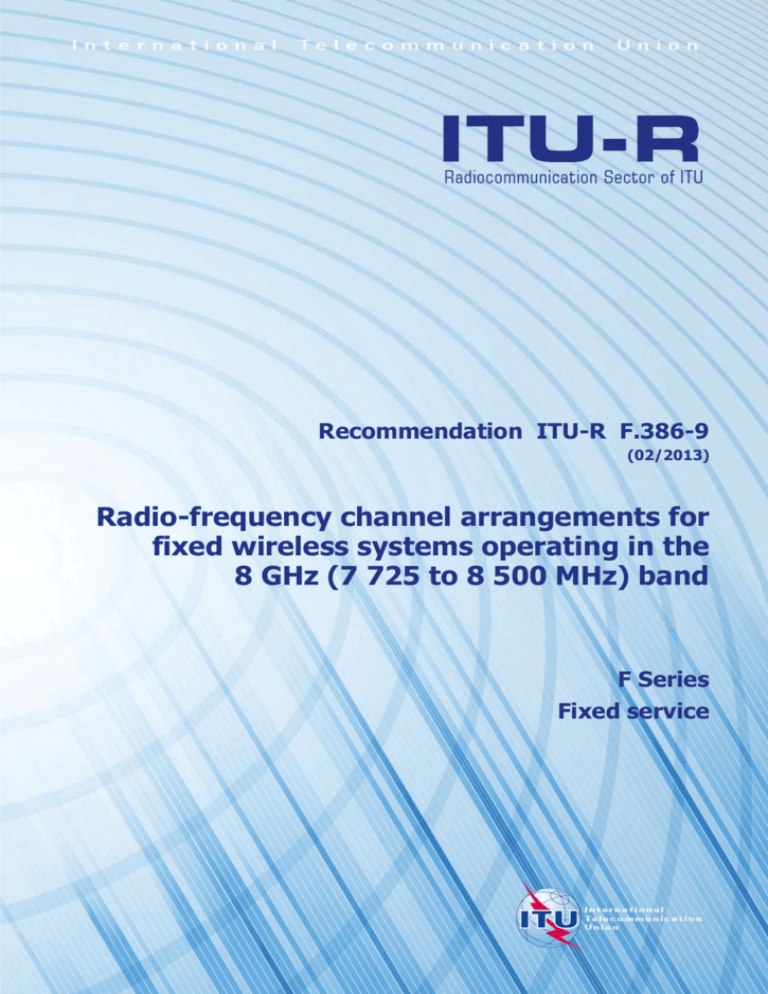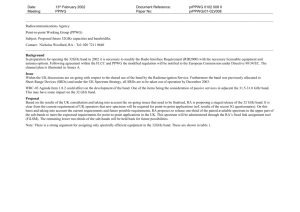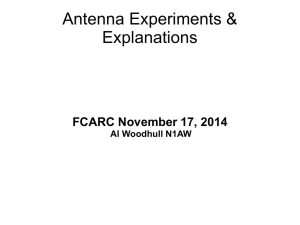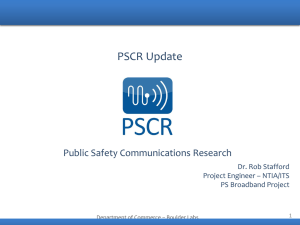
Recommendation ITU-R F.386-9
(02/2013)
Radio-frequency channel arrangements for
fixed wireless systems operating in the
8 GHz (7 725 to 8 500 MHz) band
F Series
Fixed service
ii
Rec. ITU-R F.386-9
Foreword
The role of the Radiocommunication Sector is to ensure the rational, equitable, efficient and economical use of the
radio-frequency spectrum by all radiocommunication services, including satellite services, and carry out studies without
limit of frequency range on the basis of which Recommendations are adopted.
The regulatory and policy functions of the Radiocommunication Sector are performed by World and Regional
Radiocommunication Conferences and Radiocommunication Assemblies supported by Study Groups.
Policy on Intellectual Property Right (IPR)
ITU-R policy on IPR is described in the Common Patent Policy for ITU-T/ITU-R/ISO/IEC referenced in Annex 1 of
Resolution ITU-R 1. Forms to be used for the submission of patent statements and licensing declarations by patent
holders are available from http://www.itu.int/ITU-R/go/patents/en where the Guidelines for Implementation of the
Common Patent Policy for ITU-T/ITU-R/ISO/IEC and the ITU-R patent information database can also be found.
Series of ITU-R Recommendations
(Also available online at http://www.itu.int/publ/R-REC/en)
Series
BO
BR
BS
BT
F
M
P
RA
RS
S
SA
SF
SM
SNG
TF
V
Title
Satellite delivery
Recording for production, archival and play-out; film for television
Broadcasting service (sound)
Broadcasting service (television)
Fixed service
Mobile, radiodetermination, amateur and related satellite services
Radiowave propagation
Radio astronomy
Remote sensing systems
Fixed-satellite service
Space applications and meteorology
Frequency sharing and coordination between fixed-satellite and fixed service systems
Spectrum management
Satellite news gathering
Time signals and frequency standards emissions
Vocabulary and related subjects
Note: This ITU-R Recommendation was approved in English under the procedure detailed in Resolution ITU-R 1.
Electronic Publication
Geneva, 2013
ITU 2013
All rights reserved. No part of this publication may be reproduced, by any means whatsoever, without written permission of ITU.
Rec. ITU-R F.386-9
1
RECOMMENDATION ITU-R F.386-9
Radio-frequency channel arrangements for fixed wireless systems
operating in the 8 GHz (7 725 to 8 500 MHz) band
(Question ITU-R 247/5)
(1963-1966-1982-1986-1992-1997-1999-2007-2013)
Scope
This Recommendation provides radio-frequency channel arrangements for fixed wireless systems operating
in the 8 GHz (7 725 to 8 500 MHz) band, which may be used for high, medium and low capacity systems.
The preferred radio-frequency channel arrangements are based on multiples of basic slots either of 3.5 MHz
or 2.5 MHz width. Examples in various segments of the 8 GHz band are presented in Annexes 1 to 5.
Annex 6 presents an arrangement for high capacity digital systems used in some countries.
The ITU Radiocommunication Assembly,
considering
a)
that it may be desirable to be able to interconnect fixed wireless systems (FWSs)
on international links at radio frequencies in the 8 GHz band;
b)
that the availability of frequency bands in the range from 7 725 MHz to 8 500 MHz differs
in various countries;
c)
that, for some administrations, a frequency band, only 300 MHz wide or less, may be
available in the 8 GHz range for such systems;
d)
that some channel arrangements have been developed in the past based on analogue system
requirements only;
e)
that it is desirable to deploy in such a band digital systems of low, medium and/or high
capacity. In some countries, analogue systems are still being used;
f)
that digital systems are mostly designed to accommodate radio-frequency (RF) channel
arrangements based on multiples of 2.5 MHz or 3.5 MHz patterns;
g)
that, digital techniques such as cross-polar interference cancellers (XPIC) may significantly
contribute to the cross-polar discrimination improvement factor (XIF, defined in Recommendation
ITU-R F.746), thus counteracting multipath or rain propagation-induced depolarization;
h)
that, when very high capacity links (e.g. twice Synchronous Transfer Mode-1 (STM-1)) are
required, further economy may be achieved using system bandwidths wider than the recommended
channel separation, associated to high-efficient modulation formats,
recommends
1
that the preferred RF channel arrangements be based on multiples of basic bandwidths of
either 3.5 MHz or 2.5 MHz; examples in various segments of the 8 GHz band are shown in
Annexes 1 to 5;
2
that, in a section over which the international connection is arranged, all the go channels
should be in one half of the band, and all the return channels should be in the other half of the band;
2
Rec. ITU-R F.386-9
3
that, for adjacent RF channels in the same half of the band, horizontal and vertical
polarization may be used alternately, as well as co-channel arrangements, provided that sufficient
adjacent channel rejection is provided;
4
that when very high capacity links are required and network coordination permits, with the
agreement of the administrations concerned, the use of any two adjacent 28 or 29.65 MHz channels
specified in recommends 1 is possible, for wider bandwidth system, with centre frequency lying in
the central point of the distance between the two 28 or 29.65 MHz adjacent channels;
5
that due regard be taken of the fact that, in some countries, in the 7 725 MHz to 8 275 MHz
band, another RF channel arrangement for high capacity digital systems up to 140 Mbit/s or
synchronous digital hierarchy bit rates is used. A description of this RF channel arrangement is
given in Annex 6. Administrations currently using channel arrangements based on the 29.65 MHz
raster are encouraged, in the future, to migrate to this more efficient 28 MHz and sub-multiples
channel arrangement in Annex 2.
Annex 1
RF channel arrangements for the transmission of various digital signals
operating in the 7 725-8 275 MHz band, with 300 MHz duplex spacing,
based on multiples of 2.5 MHz bandwidth referred to in recommends 1
This Annex describes an RF channel arrangement for low, medium and high capacity point-to-point
FWS using digital modulation and operating in the band 7 725-8 275 MHz. Channel pairs are
provided with a common transmit-receive separation of 300 MHz.
1
Let
The RF channel arrangement is shown in Fig. 1 and is derived as follows:
f0 be the frequency at the centre of the band:
f0 = 8 000 MHz
fn be the centre frequency of one RF channel in the lower half of the band (MHz);
f n be the centre frequency of one RF channel in the upper half of the band (MHz),
then the centre frequencies of the individual channels are expressed by the following relationships:
1.1
for systems with a 30 MHz channel bandwidth:
lower half of the band:
fn = f0 – 290 + 30 n
MHz
upper half of the band:
f n = f0 + 10 + 30 n
MHz
where:
n = 1, 2, 3, … 8;
1.2
for systems with a 20 MHz channel bandwidth:
lower half of the band:
fn = f0 – 285 + 20 n
MHz
upper half of the band:
f n = f0 + 15 + 20 n
MHz
where:
n = 1, 2, 3, … 12;
Rec. ITU-R F.386-9
1.3
3
for systems with a 10 MHz channel bandwidth:
lower half of the band:
fn = f0 – 280 + 10 n
MHz
upper half of the band:
f n = f0 + 20 + 10 n
MHz
where:
n = 1, 2, 3, … 25.
FIGURE 1
RF channel arrangements for the band 7 725-8 275 MHz
(All frequencies in MHz)
f0 = 8 000
275
1
2
3
4
5
275
6
7
8
1'
30
90
2
3
4
5
6
7
8
9 10 11 12
1'
20
3'
4'
5'
6'
7'
8'
Channel numbers = 1, 2, 3, ...8 and 1', 2', 3', ... 8'
300
1
2'
2'
3'
4'
5'
6'
7'
8'
9' 10' 11' 12'
80
Channel numbers = 1, 2, 3, ...12 and 1', 2', 3', ... 12'
300
…………
1 234
1' 2' 3' 4'
25
60
10
300
…………
25'
Channel numbers = 1, 2, 3, ...25 and 1', 2', 3', ... 25'
F.0386-01
2
Low capacity systems with RF channel bandwidths of 1.25 MHz, 2.5 MHz and 5 MHz may
also be utilized by subdividing the 10 MHz RF bandwidth pattern shown in Fig. 1.
4
Rec. ITU-R F.386-9
Annex 2
RF channel arrangements for digital FWS operating in the 7 725-8 275
and 8 275-8 500 MHz bands based on multiples of 3.5 MHz
bandwidth referred to in recommends 1
1
Channel arrangement in the frequency band 7 725-8 275 MHz
The RF channel arrangement, in a frequency band of ±275 MHz across the centre frequency
8 000 MHz for up to nine go and nine return channels, each accommodating high capacity digital
systems operating in the 8 GHz band, is as shown in Fig. 2.
Narrower channels, 18 channels 14 MHz wide and 36 channels 7 MHz wide, can be obtained by
subdivision of the 28 MHz main channels.
Channel pairs are provided with a common transmit-receive separation of 283.5 MHz.
The channels centre frequencies are derived as follows:
Let
f0 be the frequency of the centre of the band of frequencies occupied (MHz);
fn be the centre frequency of one RF channel in the lower half of this band (MHz);
f n be the centre frequency of one RF channel in the upper half of this band (MHz).
The centre frequency should be:
f0 = 8 000 MHz
then the frequencies (MHz) of individual channels are expressed by the following relationships:
1.1
28 MHz channel arrangement
The frequencies of the individual channels are expressed by the following relationships:
lower half of the band:
fn = f0 – 281 + 28 n MHz
f n = f0 + 2.5 + 28 n
upper half of the band:
MHz
where:
n = 1, 2, 3, 4, 5, 6, 7, 8 or 9.
FIGURE 2
RF channel arrangements for digital FWS operating in the 7 725-8 275 MHz band
(All frequencies in MHz)
ƒ0 = 8 000
275
22
Channel
number
275
20.5
283.5
1
2
28
3
4
5
6
7
8
1'
9
2'
3' 4' 5 '
6'
7'
8' 9'
V (H)
H (V)
59.5
F.0386-02
Rec. ITU-R F.386-9
1.2
5
14 MHz channel arrangement
The frequencies of the individual channels are expressed by the following relationships:
lower half of the band:
fn = f0 – 274 + 14 n MHz
upper half of the band:
f n = f0 + 9.5 + 14 n
MHz
where:
n = 1, 2, …… 17 or 18.
1.3
7 MHz channel arrangement
The frequencies of the individual channels are expressed by the following relationships:
lower half of the band:
fn = f0 – 270.5 + 7 n MHz
upper half of the band:
f n = f0 + 13 + 7 n
MHz
where:
n = 1, 2, …… 35 or 36.
2
Channel arrangement in the frequency band 8 2758 500 MHz
The RF channel arrangements are shown in Fig. 3 (interleaved arrangements) and Fig. 4
(co-channel reusable arrangements) and are derived as follows:
Let
f0 be the frequency of the centre of the band of frequencies occupied (MHz);
fn be the centre frequency of one RF channel in the lower half of the band (MHz);
f n be the centre frequency of a RF channel in the upper half of the band (MHz);
The centre frequency should be:
f0 = 8 387.5 MHz;
then the frequencies (MHz) of individual channels are expressed by the following relationships:
2.1
Channel arrangements, based on interleaved centre frequencies
In the interleaved channel arrangement shown in Fig. 3, adjacent RF channels on the same route can
be used only on different polarization.
28 MHz interleaved channel arrangement with duplex spacing of 119 MHz
The frequencies of the individual channels are expressed by the following relationships:
lower half of the band:
fn = f0 – 108.5 + 14 n
MHz
upper half of the band:
f n = f0 + 10.5 + 14 n
MHz
where:
n = 1, 2, 3, 4, 5, or 6;
6
Rec. ITU-R F.386-9
14 MHz interleaved channel arrangement with duplex spacing of 126 MHz
The frequencies of the individual channels are expressed by the following relationships:
lower half of the band:
fn = f0 – 108.5 + 7 n
MHz
upper half of the band:
f n = f0 + 17.5 + 7 n
MHz
where:
n = 1, 2, 3, . . . 12.
2.2
Channel arrangements, based on co-channel reusable centre frequency
When a channel arrangement permitting frequency reuse is preferred, the channels should be
derived from the above interleaved arrangement using only odd or even “n” indexes.
The actual resulting arrangements are shown in Figs 4a) and 4b).
FIGURE 3
RF channel arrangements for digital FWS operating in the 8 275-8 500 MHz band
(interleaved pattern)
(All frequencies in MHz)
f0
112.5
112.5
119
18
28
49
1
3
5
18
1'
3'
5'
H(V)
V(H)
2
4
28
6
2'
4'
6'
126
11 14
1
11
49
3
5
7
9
1'
11
3'
5'
7'
9'
11 '
H(V)
V(H)
2
4
6
8
10
12
2'
4'
6'
8'
10 ' 12 '
14
F.0386-03
Rec. ITU-R F.386-9
7
FIGURE 4
RF channel arrangements for digital FWS operating in the 8 275-8 500 MHz band (frequency reuse pattern)
(All frequencies in MHz)
f0
112.5
112.5
119
18
28
63
1
3
32
5
1'
3'
5'
H(V)
V(H)
126
11 14
1
56
3
5
7
9
18
1'
11
3'
5'
7'
9'
11'
H(V)
V(H)
a) Odd channels arrangements
f0
112.5
112.5
119
32
28
2
63
4
18
6
2'
6'
4'
H(V)
V(H)
126
18
14
2
11
56
4
6
8
10
12
2
4
6
8
10
12
H(V)
V(H)
b) Even channels arrangements
F.0386-04
NOTE 1 – When using in the same area channel 1 of the 28 MHz arrangements of the 8 275-8 500 MHz
band and channel 8’ of the 29.65 MHz arrangement of the 7 725-8 275 MHz band in Annex 6, care should be
taken to their separation of 26.43 MHz only, therefore, those two channels cannot be used on the same link.
8
Rec. ITU-R F.386-9
Annex 3
RF channel arrangements for digital FWS up to 140 Mbit/s or synchronous
digital hierarchy bit rates operating in the 7 900-8 400 MHz band, based on
multiples of 3.5 MHz bandwidth referred to in recommends 1,
with a channel separation of up to 28 MHz
1
This Annex describes a RF channel arrangement suitable for digital FWS up to 140 Mbit/s or
synchronous digital hierarchy bit rates operating in the 7 900-8 400 MHz band with a channel
separation up to 28 MHz, and makes provision for eight 28 MHz channels.
The RF channel arrangement is shown in Fig. 5 and is derived as follows:
Let
f0 be the frequency of the centre of the band of frequencies occupied (MHz);
fn be the centre frequency of one RF channel in the lower half of the band (MHz);
f n be the centre frequency of one RF channel in the upper half of the band (MHz);
then the frequencies of individual 28 MHz channels are expressed by the following relationships,
lower half of the band:
fn = f0 – 259 + 28 n
MHz
upper half of the band:
f n = f0 + 7 + 28 n
MHz
where:
n = 1, 2, 3, . . . 8.
FIGURE 5
RF channel arrangement for digital FWS up to 140 Mbit/s or
synchronous digital hierarchy bit rates operating
in the 7 900-8 400 MHz band
(All frequencies in MHz)
500
f0
26
1
3
2
28
5
4
7
6
12
1'
8
70
3'
2'
5'
4'
7'
6'
8'
266
F.0386-05
2
The eight channels with a separation of 28 MHz can be split to provide 16 channels with a
separation of 14 MHz or 32 channels with a separation of 7 MHz.
Rec. ITU-R F.386-9
9
The frequencies of individual channels are expressed by the following relationships:
2.1
for 14 MHz channels:
lower half of the band:
fn = f0 – 259 + 14 n
MHz
upper half of the band:
f n = f0 + 7 + 14 n
MHz
lower half of the band:
fn = f0 – 252 + 7 n
MHz
upper half of the band:
f n = f0 + 14 + 7 n
MHz
where:
n 1, 2, 3, . . . 16.
2.2
for 7 MHz channels:
where:
n = 1, 2, 3, . . . 32.
3
The centre frequency f0 is 8 157 MHz.
Annex 4
RF channel arrangements for the transmission of various digital signals
operating in the 7 725-8 275 MHz band based on multiples
of 2.5 MHz bandwidth referred to in recommends 1
1
This Annex describes an RF channel arrangement suitable for the transmission of various
digital signals operating in the 7 725-8 275 MHz band with a channel separation of 40, 20, 10 and
5 MHz.
The RF channel arrangement is shown in Fig. 6 and is derived as follows:
Let
f0 be the frequency of the centre of the band of frequencies occupied (MHz);
fn be the centre frequency of one RF channel in the lower half of the band (MHz);
f n be the centre frequency of one RF channel in the upper half of the band (MHz);
a)
for systems with a channel separation of 40 MHz:
lower half of the band:
fn = f0 – 295 + 40 n
MHz
upper half of the band:
f n = f0 + 15 + 40 n
MHz
where:
n = 1, 2, 3, ... 6;
10
b)
Rec. ITU-R F.386-9
for systems with a channel separation of 20 MHz:
lower half of the band:
fn = f0 – 275 + 20 n
MHz
upper half of the band:
f n = f0 + 35 + 20 n
MHz
where:
n = 1, 2, 3, ... 11;
c)
for systems with a channel separation of 10 MHz:
lower half of the band:
fn = f0 – 275 + 10 n
MHz
upper half of the band:
f n = f0 + 35 + 10 n
MHz
where:
n 1, 2, 3, ... 23;
d)
for systems with a channel separation of 5 MHz:
lower half of the band:
fn = f0 – 275 + 5 n
MHz
upper half of the band:
f n = f0 + 35 + 5 n
MHz
where:
n = 1, 2, 3, ... 47.
The centre frequency f0 is 8 000 MHz.
2
Alternatively, an effective RF channel arrangement with 20 MHz, 10 MHz, and 5 MHz
may also be used by subdividing the 40 MHz RF bandwidth pattern as shown in Fig. 7.
Rec. ITU-R F.386-9
11
FIGURE 6
RF channel arrangements for transmission of various signals operating
with 40 MHz, 20 MHz, 10 MHz and 5 MHz channel
spacing in 7 725-8 275 band
(All frequencies in MHz)
275
275
310
20
40
40
1
2
20
110
3
f0
6
2'
1'
3'
6'
a) for systems with a carrier spacing of 40 MHz
275
275
310
20
20
1
20
2
20
90
3
f0
11
1'
2'
3'
11'
b) for systems with a carrier spacing of 20 MHz
275
275
310
10
10
1
10
2
10
90
f0
23
1'
2'
3'
c) for systems with a carrier spacing of 10 MHz
3
275
23'
275
310
5
5
1
5
2
5
80
3
f0
47
1'
2'
d) for systems with a carrier spacing of 5 MHz
3'
47'
F.0386-06
12
Rec. ITU-R F.386-9
FIGURE 7
Alternative RF channel arrangements for transmission of various digital signals
operating with 40 MHz, 20 MHz, 10 MHz and 5 MHz channel spacing
in the band 7 725-8 275 MHz
7.725 GHz
8.275 GHz
310 MHz
40 MHz
110 MHz
1
2
7.745
6
7.785
1'
7.795
8.000
2'
8.055
6'
8.095
8.255
a) for systems with a carrier spacing of 40 MHz
310 MHz
20 MHz
90 MHz
1
2
3
4
7.735
7.755
7.775
7.795
11
12
7.935
7.955
1'
8.000
2'
8.045
8.065
3'
4'
11'
12'
8.085
8.105
8.245
8.265
b) for systems with a carrier spacing of 20 MHz
310 MHz
10 MHz
1
7.730
2
3
4
7.750
5
7.770
80 MHz
6
7
7.790
8
22
7.920
24
7.960
1'
8.000
2'
8.040
3' 4 '
8.060
18'
20'
22 '
24'
8.210
8.230
8.250
8.270
c) for systems with a carrier spacing of 10 MHz
310 MHz
5 MHz
75 MHz
7.9625 8.000
8.0373
8.2725
d) for systems with a carrier spacing of 5 MHz
F.0386-07
Rec. ITU-R F.386-9
13
Annex 5
RF channel arrangements for digital FWS operating in the
8 025 to 8 500 MHz band based on multiples of 3.5 MHz
bandwidth referred to in recommends 1
This Annex describes an RF channel arrangement suitable for digital FWS operating in the
8 025-8 500 MHz band with a channel separation multiple of 3.5 MHz.
The RF channel arrangement is shown in Fig. 8 and is derived as follows:
Let
fn be the centre frequency of one RF channel in the lower half of the band (MHz);
f n be the centre frequency of one RF channel in the upper half of the band (MHz);
f0 be the reference frequency (MHz),
f0 = 8 253 MHz
a)
for systems with a channel separation of 28 MHz (32 × 2 Mbit/s):
lower half of the band:
fn = f0 – 217 + 28 n
MHz
upper half of the band:
f n = f0 – 9 + 28 n
MHz
where:
n = 2, 3, . . . 7;
b)
for systems with a channel separation of 14 MHz (16 × 2 Mbit/s):
lower half of the band:
fn = f0 – 210 + 14 n
MHz
upper half of the band:
f n = f0 – 2 14 n
MHz
where:
n 2, 3, . . . 14;
c)
for systems with a channel separation of 7 MHz (8 × 2 Mbit/s):
lower half of the band:
fn = f0 – 206.5 + 7 n
MHz
upper half of the band:
f n = f0 + 1.5 + 7 n
MHz
where:
n = 3, 4, . . . 28.
14
Rec. ITU-R F.386-9
FIGURE 8
RF channel arrangements for transmission of digital FWS
operating with multiples of 3.5 MHz channel spacing
in the band 8 025-8 500 MHz
(All frequencies in MHz)
175
201
208
14
28
2
28
3
21
4
f0
7
14
68
2'
3'
4'
7'
a) for systems with a carrier spacing of 28 MHz
189
201
208
7
14
2
14
14
3
f0
14
2'
3'
b) for systems with a carrier spacing of 14 MHz
4
7
40
189
4'
14 '
201
208
3.5
7
3
7
4
10.5
5
3.5
33
f0
28
3'
4'
c) for systems with a carrier spacing of 7 MHz
5'
28 '
F.0386-08
Annex 6
Description of the RF channel arrangement
referred to in recommends 5
1
The RF channel arrangement, in a frequency band of ±275 MHz across the centre
frequency 8 000 MHz for up to eight go and eight return channels, each accommodating high
capacity digital systems up to 140 Mbit/s or synchronous digital hierarchy bit rates operating in the
8 GHz band, is as shown in Fig. 9 and is derived as follows:
Let
f0 be the frequency of the centre of the band of frequencies occupied (MHz);
fn be the centre frequency of one RF channel in the lower half of this band (MHz);
Rec. ITU-R F.386-9
15
f n be the centre frequency of one RF channel in the upper half of this band (MHz);
then the frequencies of the individual channels are expressed by the following relationships:
lower half of the band:
fn = f0 – 281.95 + 29.65 n
MHz
upper half of the band:
f n = f0 + 29.37 + 29.65 n
MHz
where:
n = 1, 2, 3, 4, 5, 6, 7 or 8.
FIGURE 9
RF channel arrangements for digital FWS with capacities
up to 140 Mbit/s or synchronous digital hierarchy bit rates operating
in the 7 725-8 275 MHz band
(All frequencies in MHz)
f0
275
275
311.32
1
3
5
7
1'
3'
5'
7'
Channel
number
2
4
6
8
29.65
2'
103.77
4'
6'
8'
F.0386-09
2
In a section over which the international interconnection is arranged, all the go channels
should be in one half of the band, and all the return channels should be in the other half of the band.
3
The go and return channels on a given section should preferably use the polarizations
shown below:
Go
H(V)
V(H)
1 3 5 7
2 4 6 8
Return
1
3 5 7
2 4 6 8
4
When additional RF channels, interleaved between those of the main pattern, are required,
the values of the centre frequencies of these RF channels should be 14.825 MHz below those of the
corresponding main channel frequencies.
5
In the case of digital FWS with a co-channel arrangement, the plan as shown in Fig. 10,
should be used.
16
Rec. ITU-R F.386-9
FIGURE 10
Co-channel arrangement for digital FWS operating
in the 7 725-8 275 MHz band
(All frequencies in MHz)
f0
275
275
311.32
1
3
5
7
1'
3'
5'
7'
Channel
number
2
29.65
4
6
8
103.77
2'
4'
6'
8'
F.0386-10
6
That, for international connections, the centre frequency should be:
f0 = 8 000 MHz
This value corresponds to the band 7 725-7 975 MHz in the lower half and 8 025-8 275 MHz in the
upper half.
NOTE 1 – The RF channel arrangement shown in Fig. 9 overlaps that mentioned in Recommendation
ITU-R F.385, for a centre frequency of 7 700 MHz, by 125 MHz between 7 725 MHz and 7 850 MHz. All
due precautions to avoid mutual interference must be taken by FWS using these channel arrangements.







